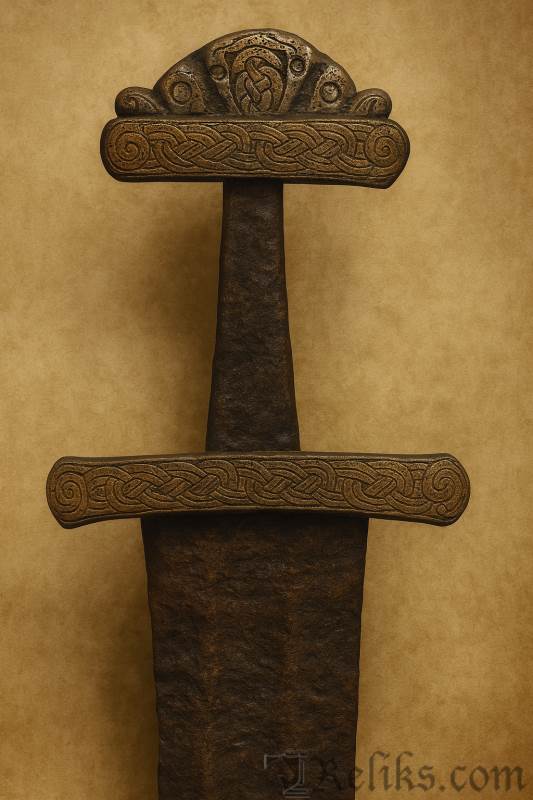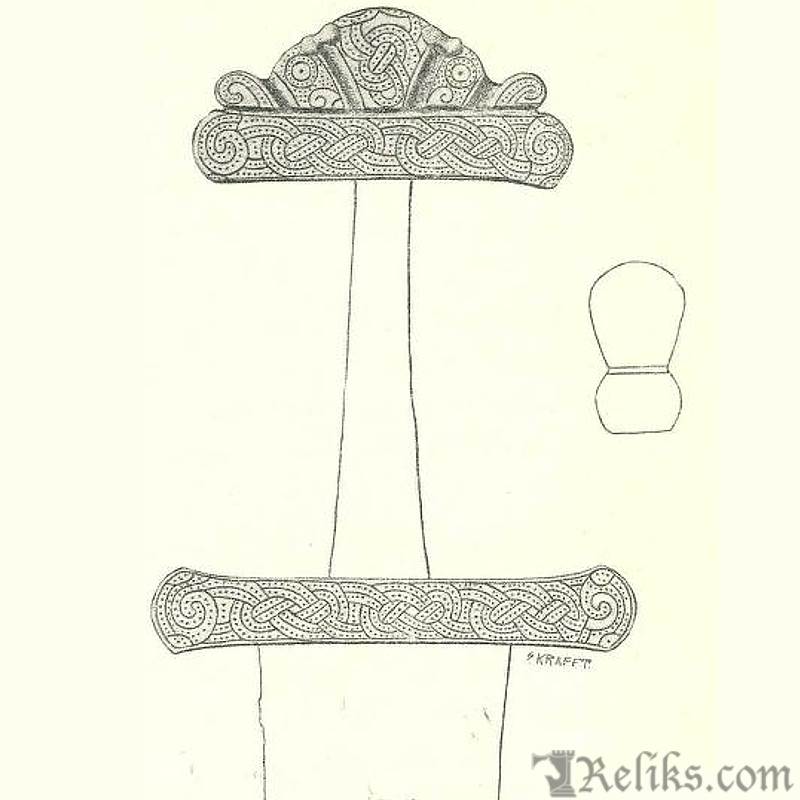Viking Sword Type R (10th Century)
Defining Features
The Type R sword is immediately recognizable for its elaborate pommel and richly decorated fittings. The pommel is technically three-part, but the addition of two grooves across the central section often gives the impression of a five-part form. This middle section is noticeably thickened and in many cases reinforced with flat brass bands. Even when the metalwork is lost, rivet holes remain to show where the bands were once attached.
The guards are always arched and expanded at both ends, upward and downward, creating a bold profile. This feature distinguishes the R-type from the related O-type, whose guards were straighter and less exaggerated. Both guards and pommel were typically covered with silver plating and intricate ornamentation, most often executed as plaited bands or interlace patterns. The pommel itself is riveted to the upper guard, and its form is thought to represent two stylized animal heads turned away from each other — a common motif in Viking art.
Distribution and Surviving Examples

Viking Sword Type R — Elite 10th Century Imported Swords
Petersen identified eight examples of Type R, all of them with double-edged blades. Three of these blades carry the famous ULFBERHT inscription — on swords from Hedmark (C 257), Vad in Etne (B 961), and Brekke in Vik (B 1204). Interestingly, while inscriptions are frequent, no true pattern-welded (damascened) blades are known from this type.
Known examples include finds from Hedemarken, Buskerud, Etne, Vik, Jølster, and Gloppen in Norway, with further parallels recorded in Denmark (Sjælland) and Sweden (Uppland). One additional specimen is illustrated in the Archaeological Journal (Vol. VII, p. 104), showing the same brass bands typical of this type.
The Norwegian finds cluster primarily in Western Norway (Bergens region) and Hedmark, reflecting both local adoption and likely points of foreign contact.
Dating and Archaeological Context
Type R belongs to the 10th century, with its main period of use probably around the middle of the century. Contextual evidence comes from associated finds:
- At Øvre Teige in Sigdal (C 16157), the sword was buried with a broad-bladed spear, an L-type axe, a young-style rattle, and a low shield boss (R 565).
- At Dalseng in Vang, Hedmark (C 3689), an L-type axe was found with the sword.
- In the great “Bruhaugen” hoard from Vik, a Type R blade (B 1204) was discovered alongside swords of Q-type, older H-types, spearheads of F- and G-types, and E-type axes.
These combinations consistently point to the 10th century, with emphasis on the decades around 950. The presence of G-type spearheads in several finds, which emerge only after mid-century, further supports this dating.
Origins and Interpretation

Petersen (fig.113)
Type R is almost certainly of foreign origin. The frequent presence of Ulfberht blades — imported from the Rhineland — and the elaborate silver and brass decoration strongly suggest that this was a sword type brought into Norway from Western Europe. Its restricted but telling distribution in western coastal districts aligns with established trade and cultural links across the North Sea.
The elaborate design and imported blades indicate that these were elite weapons, markers of wealth and foreign connections. Their rarity — only eight known in Norway — further supports the idea that Type R swords were prestige imports, acquired by chieftains and magnates engaged in continental exchange.
Legacy
Type R stands apart from the more numerous domestic forms like M and Q. It shows how Viking Age Norway did not only produce its own sword traditions but also absorbed and reinterpreted continental fashions. Its interlace ornamentation, foreign inscriptions, and distinctive animal-head pommel all make it one of the most striking examples of cultural cross-pollination in Viking weaponry.
Core classification based on Jan Petersen, De Norske Vikingesverd (1919). Additional commentary by Reliks.com.